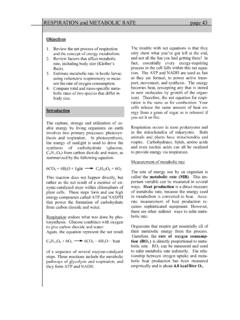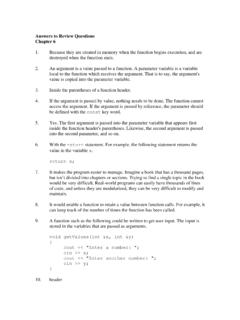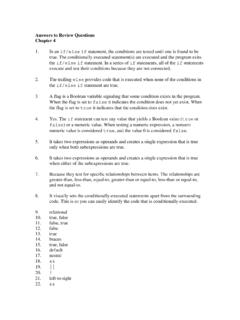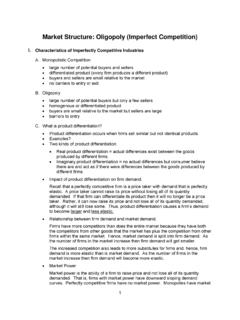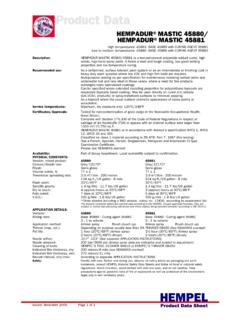Transcription of Monopoly and Perfect Competition Compared
1 Monopoly and Perfect Competition Compared I. Definitions of Efficiency A. Technological efficiency occurs when: Given the output produced, the costs of production (recourses used) are minimized. or Given the costs of production (resources used), the output produced is maximized. There are two kinds of technological efficiency: Firm technological efficiency Given the output produced by the firm, the firm must minimize the costs of production. A firm's average cost curve shows, given the quantity produced, the minimum average cost for which that quantity can be produced. Hence, firm technological efficiency occurs whenever, given the quantity produced, the firm is producing on their cost curves. All profit- $. ATC. maximizing firms wish to achieve firm technological efficiency because decreasing costs will increase profits. $20. In the graph to the right, the firm producing quantity level Q1 at an average cost of $20.
2 Illustrates firm technological efficiency. The firm cannot produce this at an average cost below $20 and if it produces it at an average cost above $20, then it is technologically Q1 Quantity inefficient. Industry technological efficiency Given the output produced by the industry, the industry must minimize the costs of production. An industry can be technologically inefficient even though all firms in the industry are technologically efficient. This possibility is illustrated in the graph to the right, which represents the ATC curve for each firm in the industry. Consider the $. following two scenarios: ATC. $20. Scenario 1: The output produced by the industry equals 10 million. The industry output is produced by 10,000 individual firms in the industry each producing 1,000 units of $10. output. Each firm producing this output does so in a technologically efficient manner ( , each firm produces on their cost curves).
3 Thus in the industry ATC equals $20. 1,000 2,000 Quantity Scenario 2: The output produced by the industry equals 10 million. The industry output is produced by 5,000 individual firms in the industry each producing 2,000. units of output. Each firm producing this output does so in a technologically efficient manner ( , each firm produces on their cost curves). Thus in the industry ATC equals $10. 1. Even though in both scenarios the firms in the industry are technologically efficient ( , are producing on their cost curves given the quantity produced), the average cost of producing the industry output is not the same. The industry output is produced at the lowest possible average cost in scenario 2, where each firm is producing at the minimum point of their ATC curve. Thus, industry technological efficiency requires that each firm in the industry produce where its ATC is at its minimum point. B.
4 Allocative efficiency occurs when: Resources are allocated to the production of a good or goods in such a manner that society is a well off as possible. Earlier in the semester allocative efficiency was defined to occur whenever all possible mutually beneficial exchanges had occurred. However, this definition is inadequate given our current level of understanding. Hence, we will define allocative efficiency in terms of two marginal concepts: Marginal Social Cost (MSC). MSC equals the extra cost to society of producing one more unit of output. The law of diminishing returns implies that MSC will be upward sloping. Marginal Social Benefit (MSB). MSB equals the extra benefit to society of producing one more unit of output. The law of diminishing marginal utility implies that MSB will be downward sloping. The graph to the right is divided into two areas: MSB > MSC. For example, consider the th MSB > MSC MSB < MSC.
5 Decision to produce the 20 unit of output. $. th It costs society $10 to produce the 20. unit, but yields a benefit of $20. Hence, MSC. society's welfare increases, on net, by $10 $20. th (MSB MSC) if society produces the 20. unit of output. Clearly it is in society's best th interest to produce the 20 unit of output. $10. MSB. In fact, as long as MSB exceeds MSC, society is made better off by increasing output. 20 30 40 Quantity MSB < MSC. For example, consider the th decision to produce the 40 unit of output. th It costs society $20 to produce the 40 unit, but yields a benefit of only $10. Hence, society's welfare increases, on net, by $10 (MSB MSC) if society does th not produce the 40 unit of output. Clearly it is not in society's best interest to th produce the 40 unit of output. In fact, as long as MSB is less than MSC, society is made better off by decreasing output. Given that society is better off when output is (1) increased when MSB > MSC and (2) decreased when MSB < MSC, it is clear that allocative efficiency occurs where MSB = MSC.
6 As a final step, recall that Demand curves measure the maximum price that consumers are willing to pay for a given quantity of a good. That is, a consumer's Demand curve is a measure of marginal benefit (or marginal utility) to the consumer. Which means that Market Demand measures the marginal benefit for all consumers in the market. In the absence of externalities, Market Demand measures marginal social benefit. Thus, we can say that MSB = D = P. 2. Recall also that in perfectly competitive industries, the market supply curve is a measure of the marginal cost in the industry. In the absence of externalities, this marginal cost equals the marginal social cost. Thus, we can say that MSC = S =. MC. Thus, allocative efficiency occurs whenever: MSB = MSC. P = MC. Allocative efficiency can be referred to in either of these two methods. However, it is more common to use the latter, P = MC, than the former.
7 In fact, on the departmental final exam you can expect allocative efficiency will always be defined as occurring where P = MC. II. Evaluating the Efficiency of Perfectly Competitive and Monopoly Markets A. The long-run in a perfectly competitive market. The graph below demonstrates the long- run equilibrium in a perfectly competitive market, where profit equals zero Price Price MC. AT C. S. Pm = AT C Pm Df =. MR. D. q* quantity Q1 Quantity Firm Market We observe that the following is the case for a perfectly competitive market in long-run equilibrium: Profit ( ) = 0 because P = ATC. P = MR = MC = Df = ATC. The firm is producing the quantity where ATC is at its minimum point. Technological Efficiency for the Perfectly Competitive Market Firm Technological Efficiency: Is the firm producing on its cost curves? Yes. First, all profit-maximizing firms wish to minimize the cost of producing a given quantity because reducing costs increase profits.
8 Second, profit equals zero for a perfectly competitive firm in long-run equilibrium. Hence, if the firm did not choose to minimize the cost of producing its output by producing on its cost curves, ATC. would increase and profit would be less than zero. In the long-run, the firm would be driven out of business by its more efficient competitors. Industry Technological Efficiency: Are all firms in the industry forced to produce at the quantity where its ATC is at the minimum point? Yes. 3. Allocative Efficiency for the Perfectly Competitive Market Is the firm producing where P(MSB) = MC(MSC)? Yes B. The long-run in a Monopoly . The graph below demonstrates the long-run equilibrium for a Monopoly , where profit is greater than or equal to zero. Price MC. profit >. 0. AT. C. P*. AT C. Df = D. MR. q* Quantity We observe that the following is the case for a Monopoly in long-run equilibrium: Profit ( ) 0 because P ATC.
9 P ATC; P > MC, P > MR = MC. The firm is not producing the quantity where ATC is at its minimum point. Technological Efficiency for the Monopoly Market Firm Technological Efficiency: Is the firm producing on its cost curves? Recall that all profit-maximizing firms wish to minimize the cost of producing a given quantity because reducing costs increase profits. Industry Technological Efficiency: Is each firm in the industry producing at the minimum point of its ATC curve? No. Allocative Efficiency for the Monopoly Market Is the firm producing where P = MC? No. Price is greater than ATC. Hence, the firm is producing too little at too high a price. Is the industry producing where MSB (D) = MSC (S)? For Monopoly , there exists no supply curve. C. Final Comparisons: Perfect Competition versus Monopoly See the graph below for comparisons. Perfectly competitive firms have the least market power ( , perfectly competitive firms are price takers), which yields the most efficient outcome.
10 Monopolies have the most market power, which yields the least efficient outcome. Least Market Power/ Most Market Power/. Most Efficient Least Efficient Perfect Monopoly Competition 4. Public Policy given this analysis? The policy that follows from the above analysis is straightforward. Perfectly competitive industries yield efficient outcomes while monopolies yield inefficient outcomes. Hence, an appropriate policy, whose goal is to increase efficiency, would be to reduce Monopoly power and by increasing the level of Competition in Monopoly markets. III. Exceptions to this Analysis There are two possible types of exceptions to the conclusion that perfectly competitive industries are efficient while Monopoly industries are inefficient. Either (1) Perfect Competition is not as efficient as thought OR (2) Monopoly is not as inefficient as thought. Below, exceptions of both types will be described.
